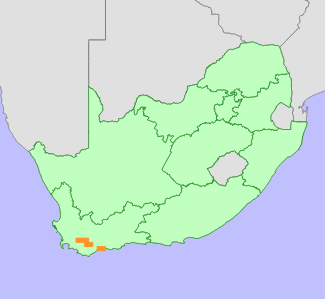|
Scientific Name | Leucospermum utriculosum Rourke |
Higher Classification | Dicotyledons |
Family | PROTEACEAE |
Common Names | Breede River Pincushion (e) |
National Status |
Status and Criteria | Least Concern |
Assessment Date | 2019/06/25 |
Assessor(s) | A.G. Rebelo, H. Mtshali & L. von Staden |
Justification | Leucospermum utriculosum has a limited distribution range, with an Extent of Occurrence of 1746 km², and an Area of Occupancy of 172 km². It is fairly common in the northern part of its range, and still persists at at least 20 locations. It is potentially threatened by competition from alien invasive plants on the Potberg, but subpopulations in the Breede River Valley are not threatened. |
Distribution |
Endemism | South African endemic |
Provincial distribution | Western Cape |
Range | Leucospermum utriculosum has a limited distribution range in the Western Cape. It occurs in two disjunct areas, Potberg Mountain on the eastern edge of the Agulhas Plain, and in the Breede River Valley between Worcester and Stormsvlei. |
Habitat and Ecology |
Major system | Terrestrial |
Major habitats | Potberg Sandstone Fynbos, North Sonderend Sandstone Fynbos, Breede Quartzite Fynbos, Albertinia Sand Fynbos |
Description | It occurs on dry rocky north-facing slopes in sandstone and quartzite fynbos, 30-700 m. Mature individuals are killed by fires, and only seeds survive. Seeds are released after ripening, and dispersed by ants to their underground nests, where they are protected from predation and fire. It is pollinated by birds. |
Threats |
| The Potberg was formerly densely invaded with wattles, that were threatening to displace native species. Efforts were made to clear invasive plants, but eradication is proving difficult due to persistent seed banks, from which invasive wattles regenerate profusely following natural wildfires.
Areas surrounding subpopulations in the Breede River Valley have been planted with vineyards, but this species is unlikely to have suffered significant declines, as its rocky habitat is not suited to cultivation. A very small proportion (5%) of its habitat is irreversibly modified, but there is no ongoing loss. |
Population |
This species is known from dense isolated stands in the north and many scattered plants in the south. It is not suspected to be declining, but requires monitoring.
|
Population trend | Stable |
Assessment History |
Taxon assessed |
Status and Criteria |
Citation/Red List version | | Leucospermum utriculosum Rourke | Least Concern | Raimondo et al. (2009) | |
Bibliography |
Goldblatt, P. and Manning, J.C. 2000. Cape Plants: A conspectus of the Cape Flora of South Africa. Strelitzia 9. National Botanical Institute, Cape Town.
Raimondo, D., von Staden, L., Foden, W., Victor, J.E., Helme, N.A., Turner, R.C., Kamundi, D.A. and Manyama, P.A. 2009. Red List of South African Plants. Strelitzia 25. South African National Biodiversity Institute, Pretoria.
Rebelo, T. 2001. Sasol Proteas: A field guide to the proteas of southern Africa. (2nd ed.). Fernwood Press, Vlaeberg, Cape Town.
|
Citation |
| Rebelo, A.G., Mtshali, H. & von Staden, L. 2019. Leucospermum utriculosum Rourke. National Assessment: Red List of South African Plants version . Accessed on 2025/07/04 |
 Comment on this assessment
Comment on this assessment

